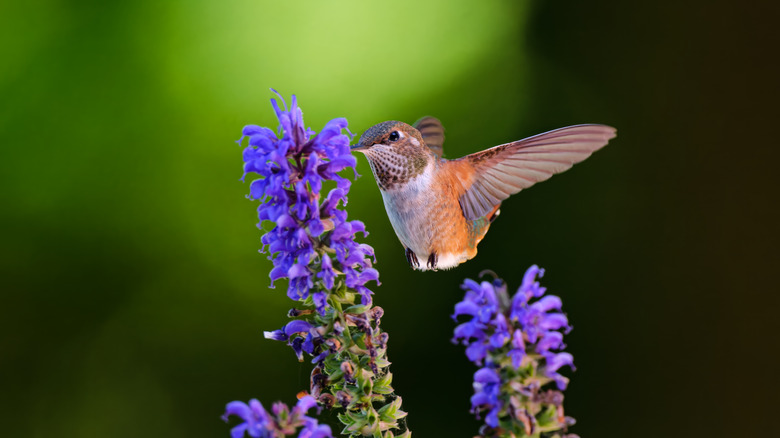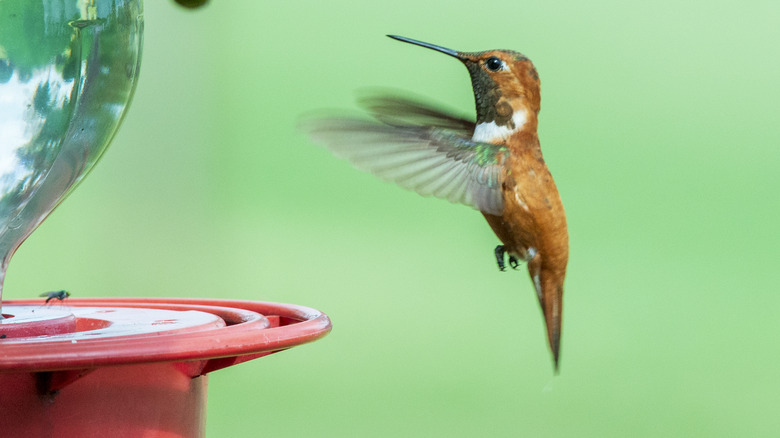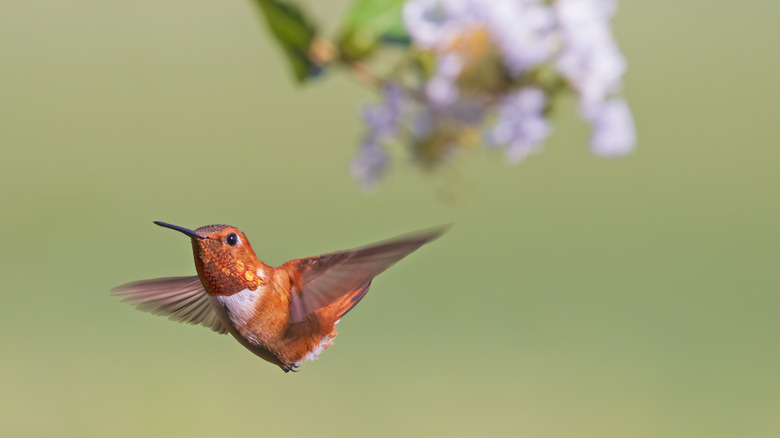The Aggressive Hummingbird You Might Not Want To See In Your Yard
Hummingbirds have a Napoleon complex. Tiny yet tough, these avian friends are fiercely territorial and often startlingly aggressive. It really is a funny reality check, since these birds are known for their beauty and extremely light weight. If you've never witnessed the angry buzzings of a rufous hummingbird, you might not have thought that one of the world's smallest bird species has a standout bully that can fight to the death. This is one hummingbird that might chase other birds from your yard. Despite being one of the smaller hummingbirds, some people think they are the feistiest of their kind. You're likely to have rufouses on your hands if you spot a small, red-orange bird with a flashy orange throat dive-bombing your backyard visitors. Females have green hues on their upper bodies.
If you live in the western portion of North America — from Oaxaca, Mexico, north to Alaska — you may have rufouses, especially males, careening toward other hummingbirds as they attempt to sip from your feeder. These little guys even have a squint in their eyes that looks grumpy. They are the playground thugs of your yard, but they're inarguably cute and entertaining. If you'd like a space where all hummingbirds can feed without too much conflict, there are some steps you can take. They don't stick around long, so your worries won't last. Plus, sharing a space with them for only one or two weeks a year is a gift that most people on the continent don't receive.
How to prevent bird fights
Scaring birds away from your feeders is considered poor form by bird lovers. Short of giving them a big fright, you can mitigate possible problems with a few humane but savvy tricks.
Most hummingbird fights are over food sources. Try placing clusters of feeders in various places in your yard. Setting up multiple feeding spaces — some out of sight of the others — can reduce the rufouses' desire to lord over the area. Some professionals advise hanging more feeders after July 4, when rufouses start to pass through on their southern migration. Luckily, you don't need to buy a bunch of new hummingbird feeders, as DIY hummingbird feeders are easy to make. If you have one particular hummingbird that's making a nuisance of himself (yes, he's most likely to be male) try to pinpoint his hangout; rufouses like to scope out their realm from a favorite spot. If you notice a perch or a branch he favors, you can move the perch or trim the branch. At the very least, knowing the feeder he favors will let you hang the other feeders away from his turf.
Enjoy things that make rufouses special
Yes, the rufouses can be pesky, but they are lovely and full of superlatives. They can breed farther north than any other hummingbird, into Canada and Alaska, and they've been known to frighten off hummingbirds twice their weight. Rufouses also migrate the farthest of any hummingbird. In addition to the jaw-dropping 4,000 miles they migrate round-trip in a year, rufouses are the most common Western hummingbirds that show up in the Eastern U.S. Keep in mind, though, that they don't usually travel farther east than the Rockies.
Their namesake reddish-orange plumage that glows in the sun also sets rufouses apart. They are the only North American hummingbird to have this coloring on their backs. Rufouses may be a pain for the other hummingbirds, but they tend to move on after a couple of weeks.
More importantly though, rufouses are under threat. Their populations have dropped by 60% since the late 1960s, and researchers aren't sure why. By taking steps to keep fighting at bay and mitigate territorial behavior while still offering food for these amazing creatures, you're doing your part to help protect this species. If you live in the Western U.S. and want rufouses and other hummingbirds to visit your yard, check out these tips on how to attract more hummingbirds to your garden.


